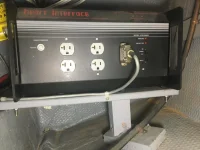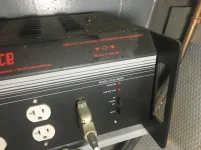Nick in Manitou
Active member
- Joined
- Jan 15, 2019
- Messages
- 140
- Status
- OWNER - I own a Hatteras Yacht
- Hatteras Model
- 53' EXTENDED DECKHOUSE (1983 - 1988)
When we purchased our boat about a year ago, it came with a Heart Interface Model HF32-3000X.
Nothing was connected to it and it was turned off.
Because there are no 110v outlets in the generator space where I wanted to run a small (.65 amp) dehumidifier, I figured that I would try the inverter.
I turned it on and tested an outlet on the front of it with a household outlet tester and it showed up as having no ground connection. Since the device I was trying to power has only a 2 prong plug I wasn't too concerned about the lack of a ground.
After I plugged the inverter in, I happened to notice that the ammeter on the Lewco battery charger in the engine room was bouncing around like crazy. As soon as I turned the inverter back off the battery charger ammeter went back to its very low and stable (normal) state.
I have had no experience with inverters up to this point and don't know what I am dealing with. I have not been able to find a manual for this unit. If the unit is dead I will probably just remove it and not replace unless I have a real need to do so.
I am making an assumption that the fluctuating ammeter on the battery charger indicates a problem and that the inverter should be repaired or disconnected.
Any thoughts?


Thanks!
Nick
Nothing was connected to it and it was turned off.
Because there are no 110v outlets in the generator space where I wanted to run a small (.65 amp) dehumidifier, I figured that I would try the inverter.
I turned it on and tested an outlet on the front of it with a household outlet tester and it showed up as having no ground connection. Since the device I was trying to power has only a 2 prong plug I wasn't too concerned about the lack of a ground.
After I plugged the inverter in, I happened to notice that the ammeter on the Lewco battery charger in the engine room was bouncing around like crazy. As soon as I turned the inverter back off the battery charger ammeter went back to its very low and stable (normal) state.
I have had no experience with inverters up to this point and don't know what I am dealing with. I have not been able to find a manual for this unit. If the unit is dead I will probably just remove it and not replace unless I have a real need to do so.
I am making an assumption that the fluctuating ammeter on the battery charger indicates a problem and that the inverter should be repaired or disconnected.
Any thoughts?


Thanks!
Nick

